コラム
落合憲弘
John Sypal
タカザワケンジ
なぎら健壱

This week let’s look at some photos taken in my favorite part of my favorite park in Tokyo: Bentenjima in Ueno Park. The focal point of Shinobazu Pond, it’s attracted people for centuries- and photographers as long as there have been cameras. There’s just really something about this place. Even though it’s been continually remodeled and is now inundated with tourists, it remains one of those odd, magical spots in the city. Recently, I’ve been visiting Shinobazu Pond a few times a week. It has a sort of pull that I can’t quite explain. It’s got a history (and its own Wikipedia page: https://en.wikipedia.org/wiki/Shinobazu_Pond), and, without any tall buildings nearby, the light is good from morning to evening. Things are always happening here- people eat, gawk, pray, and, most importantly, take photos.
今週は、私が東京で一番好きな公園にある、一番好きな場所で撮った写真を紹介します。上野公園にある弁天島です。不忍池の中心にあるこの場所は、何世紀にもわたって人々を魅了し、カメラがある限り、写真家たちをも魅了してきました。この場所には本当に何かがあるんです。不忍池の池畔には、昔から多くの人が訪れ、カメラマンも多く足を運びました。私も最近は週に何度か不忍池を訪れています。不忍池には、何とも言えない魅力があります。歴史があり、近くに高い建物がないため、朝から夕方まで光がよく入る場所です。人々は食事をし、見物し、祈り、そして最も重要なことは、写真を撮ることです。
Wikipedia:https://en.wikipedia.org/wiki/Shinobazu_Pond
Here are a few I’ve seen in photobooks in my collection.
私個人の写真集コレクションで発見した不忍池・弁天島の写真を紹介します。
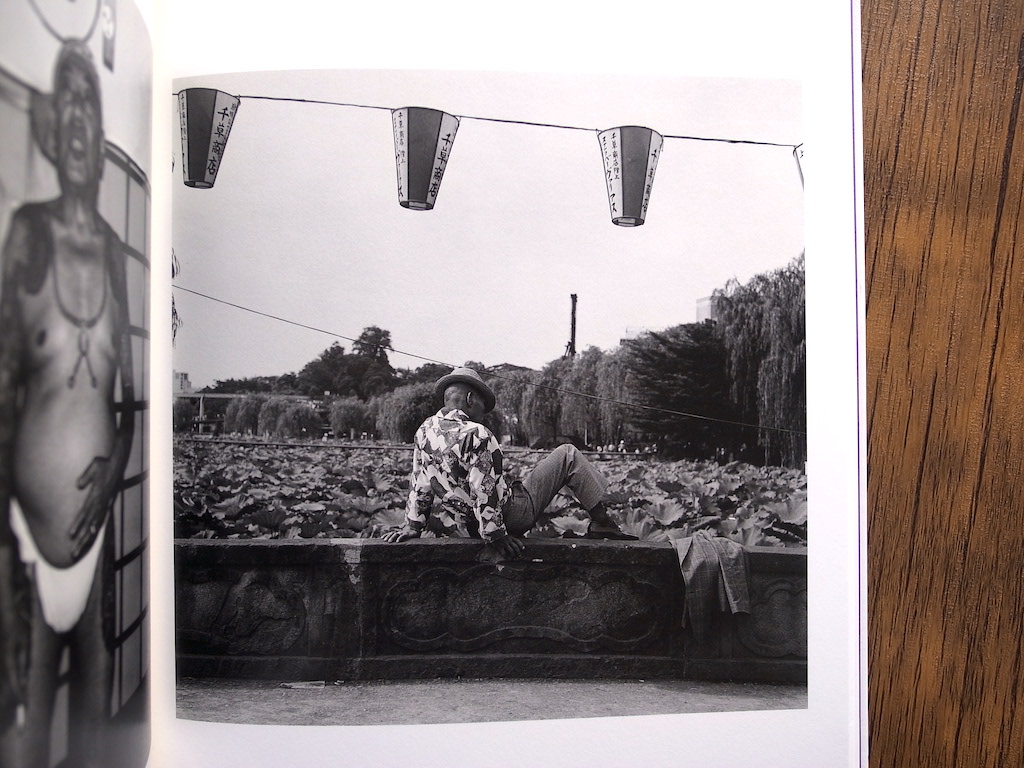
First up is this photo, by Issei Suda. It appears in Waga Tokyo, 100 (first published in 1979, seen here in The Zen Foto 2013 edition) and was one of the locations in the book which I recognized immediately:
さて、一枚目は須田一政の『わが東京100』(初版1979年/復刻版2013年、禅フォト)です。石橋の上に座っているおじさん。この小さなかわいい石橋は「天龍橋」という名前がつけられています。ネットで調べてみたところ、1672年、船で移動していた弁天島や弁天堂に歩いて行くことができるようにするために作られたことがわかりました。
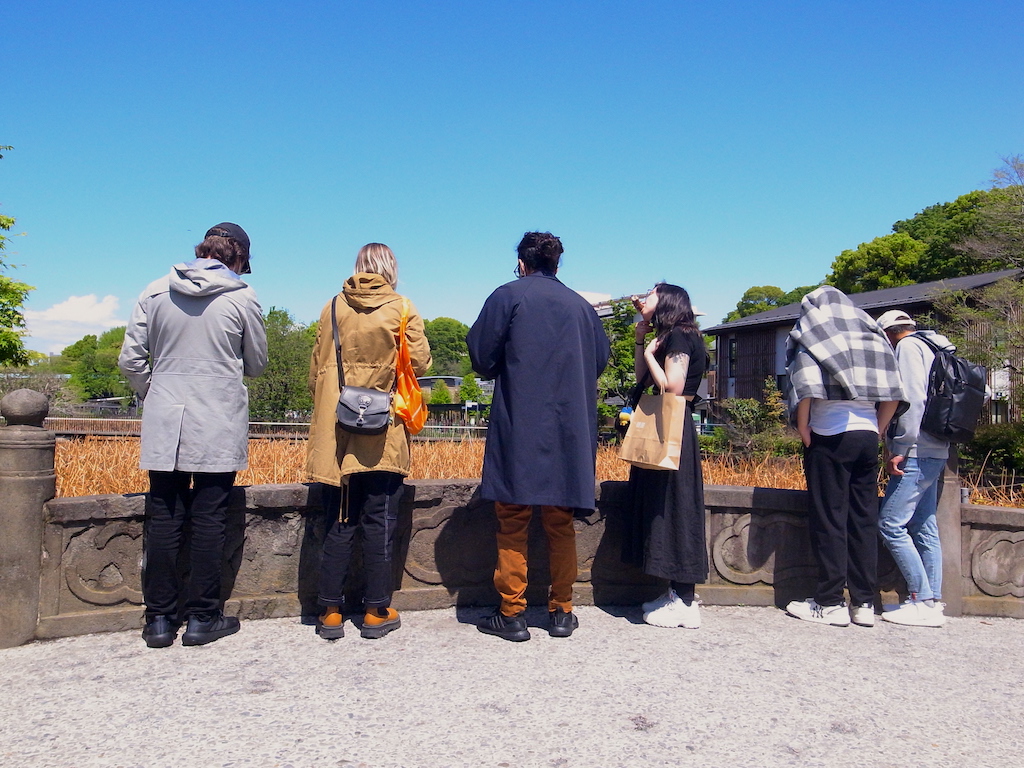
The man in it sits on the north edge Tenryu Bridge. This small stone bridge was built in 1672 to give visitors to access Bentenjima and the Bentendo temple on foot, instead of by boat.
As you can see, the bridge’s parapet is quite low. Such a design might have been fine for the seventeenth century but it might be a little too low for the twenty-first, particularly when the bridge is full of people on their iPhones. Thankfully though, just prior to sakura season the city annually installs a higher guardrail made of metal pipes on either side. I was on this bridge at the peak of Sakura Season in mid-March- it was as crowded as a rush-hour train. That pipe railing was a good idea, as it surely prevents people from falling over into the muck. Rather a life-threatening experience (the pond is less than 90cm deep) that kind of tumble would probably just really ruin one’s day.
I can’t help but wonder though- how many people have fallen over the side in the past 351 years?
ご覧のように、橋の欄干はかなり低いです。17世紀ならまだしも、21世紀の今、橋の上でiPhoneをいじっている人たちを見ると、このデザインはちょっと低すぎるかもしれません。池に落ちたら大変。しかしありがたいことに、桜の季節になると毎年、金属パイプでできた高いガードレールを左右に設置しています。私は今年の3月中旬にこの橋を通ったのですが、動けないほどの混雑でした。あのパイプの手すりは、確かに泥の中に人が落ちるのを防いでいました。池の平均深さは90cmもないらしいので命にかかわるというより、その日一日を台無しにしてしまうぐらいでしょう。この351年間に、いったい何人の人がこの橋から池に転落したのだろう…?
Here’s another snap of the bridge, this one by Suda’s student, photographer Mitsugu Ohnishi, seen in his book Wonder Land 1980-1989 (FROG 1989).
天龍橋のもう一枚。これは須田さんの教え子でもある、写真家・大西みつぐさんの『Wonder Land 1980-1989』にある写真です。

That’s the south edge of the bridge. Come to think of it, the spot where the couple is standing in Ohnishi’s photo is just about where Suda would have been to take his photo.
橋の南端です。そういえば、大西さんの写真でカップルが立っている場所は、ちょうど須田さんがさっきの写真を撮ったであろう場所ですね。
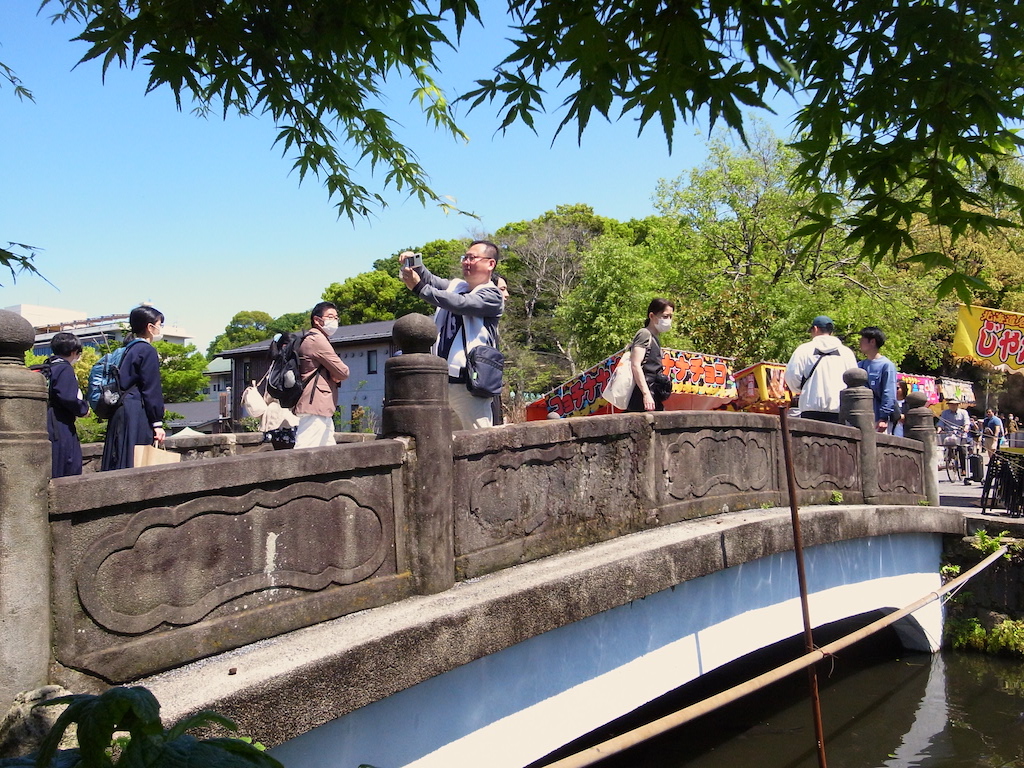
I know that I owned a copy of Wonder Land 1980-1989 before I ever saw Waga Tokyo, 100. This means that, even though Suda’s photo was actually taken and published years before Ohinishi’s, the younger photographer’s image was “first” for me. Since photographs are in a way removed from the flow of time, they’re destined to “happen” in the order each particular viewer encounters them.
私は須田さんの『わが東京100』を見る前に、大西さんの『Wonder land 1980-1989』を先に見ていました。つまり、須田さんの写真は大西さんの写真より何年も前に撮影され出版されているにもかかわらず、私にとって、大西先生の写真の方が最初だったということです。
Here’s another photo by Ohnishi sensei, taken a few meters west of the bridge, looking east. This appears near the end of his book Wonderland (Nippon Camera, 2008).
こちらも大西先生が弁天島で撮った写真。さっきの写真の数メートル西側で東を向いて撮影したものだそうです。写真集『Wonderland』(日本カメラ社、2008年)に掲載されています。
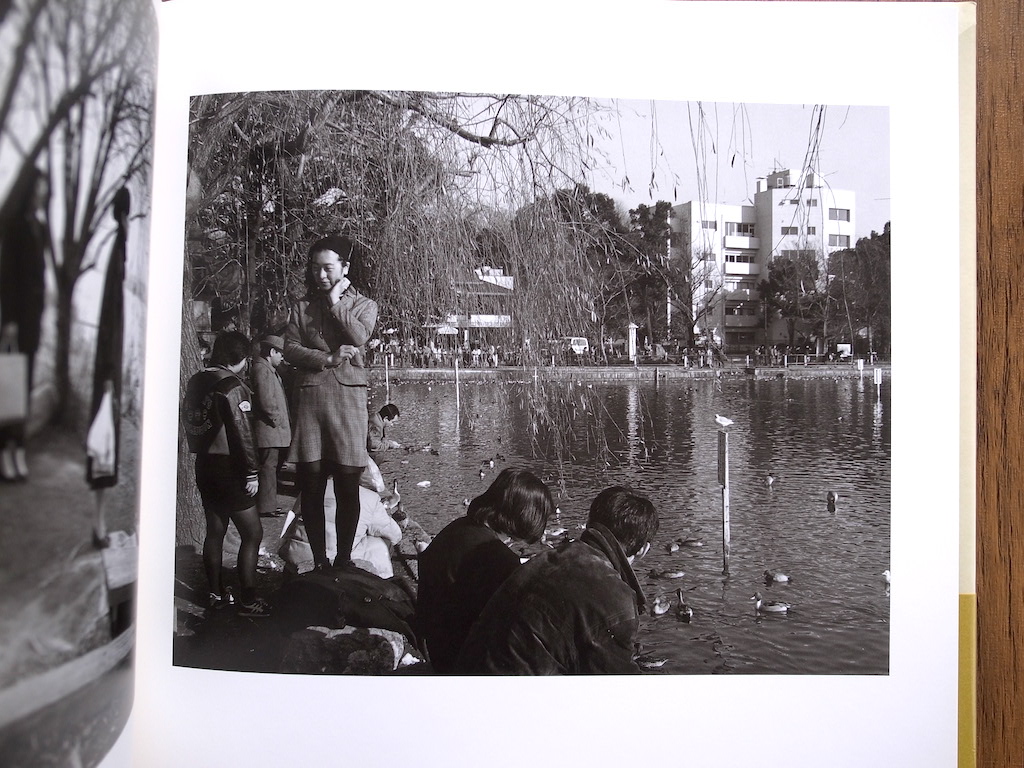

In addition to being interesting images, these photos all mark changes in this area. On the earthen part of the bridge that connects the island to the park (just before Tenryu Bridge), there were once large stone lanterns, as seen in this 1980 photo* by Issei Suda:
*This photograph appears in “Journey to the Tobacco Shop on the Corner”, published by Place M in 2011.
これらの写真は、興味深い画像であると同時に、この地域の変化を示すものでもあります。島と公園を結ぶ橋の土の部分(天龍橋の手前)には、かつて大きな石灯籠があったことわかります。写真は須田一政さんが1980年に撮られた写真です。この写真は、2011年にPlace Mから出版された『角の煙草屋までの旅』に掲載されたものです。

And in this one by Nobuyoshi Araki, published in the June 2003 issue of Asahi Camera Magazine:
2003年6月号の『アサヒカメラ』で荒木経惟さんがほぼ同じ場所から撮影した写真を発見しました。
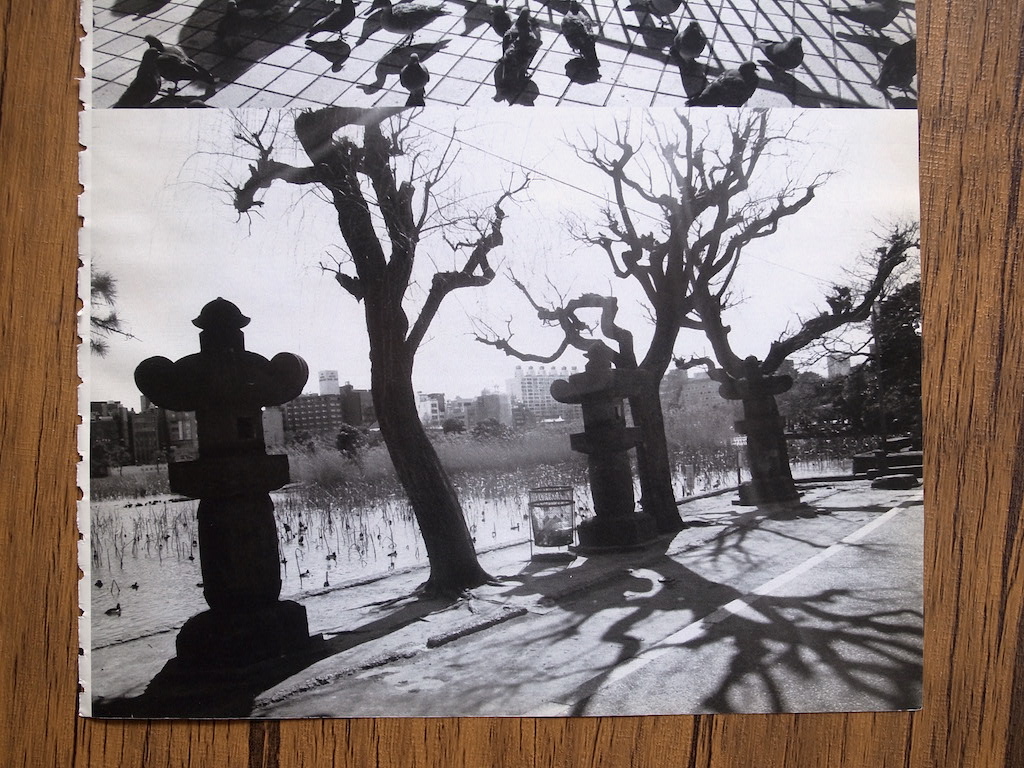
I apricate the directness of both photographs- this is the first thing you see on your left when approaching the island. I can’t remember exactly when these lanterns were removed- but since it’s a high-traffic pedestrian area, I assume that they were relocated due to earthquake safety. I’d much rather slip and fall into the pond than be next to one of these in a big quake. I’m curious where they are now. For most of the year, they are replaced with food stalls.
この灯籠がいつ撤去されたのかはよく覚えていませんが、人通りの多い場所なので、地震の安全性を考慮して移設されたのだと思います。地震でこの灯籠の隣にいるくらいなら、滑って池に落ちたほうがましでしょうね。今、この灯籠はどこにあるのか気になります。現在は、屋台に取って代わられています。
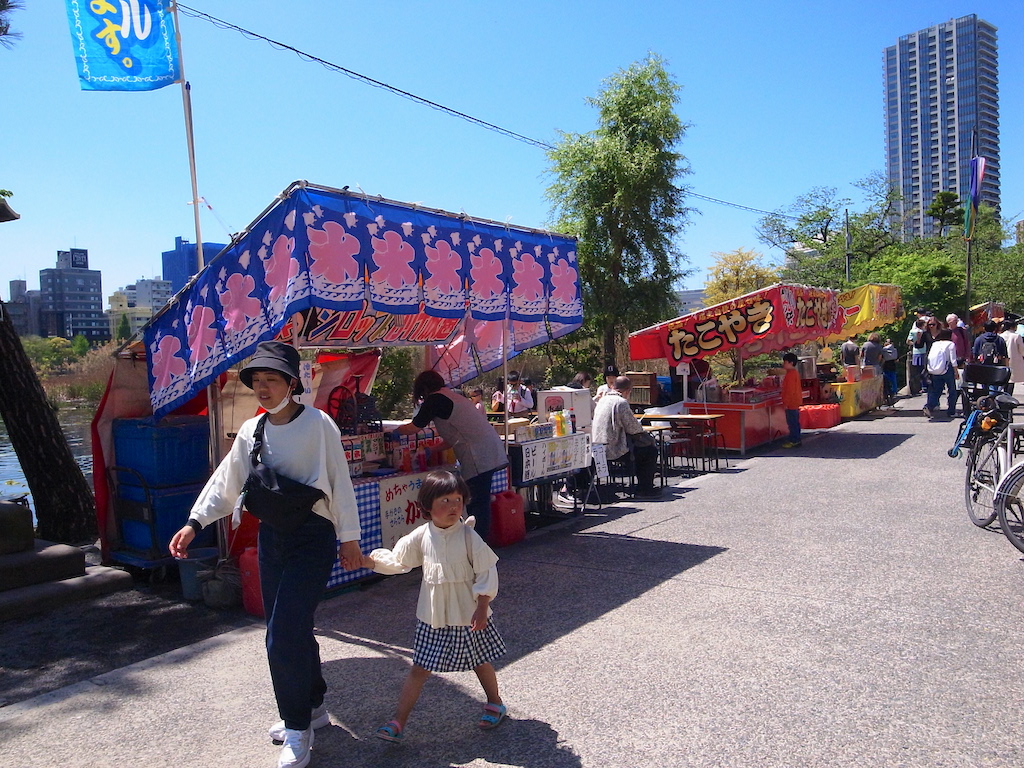
Here’s the same spot in 2023:
2023年に撮影した同じ場所です。
Suda must have walked this path many times- I spotted another photo of this same spot from the 1970s in the “Red Flower” section of his Tokyo Museum of Photographic Art catalog “Fragments of Calm” (Tosei-sha, 2013)
須田一政さんはこの道を何度も歩いたのでしょう。東京都写真美術館の図録『凪の片』(冬青社、2013年)の「紅い花」の項にも、1970年代の同じ場所の写真があるのを見つけました。ほら、灯籠は同じ。
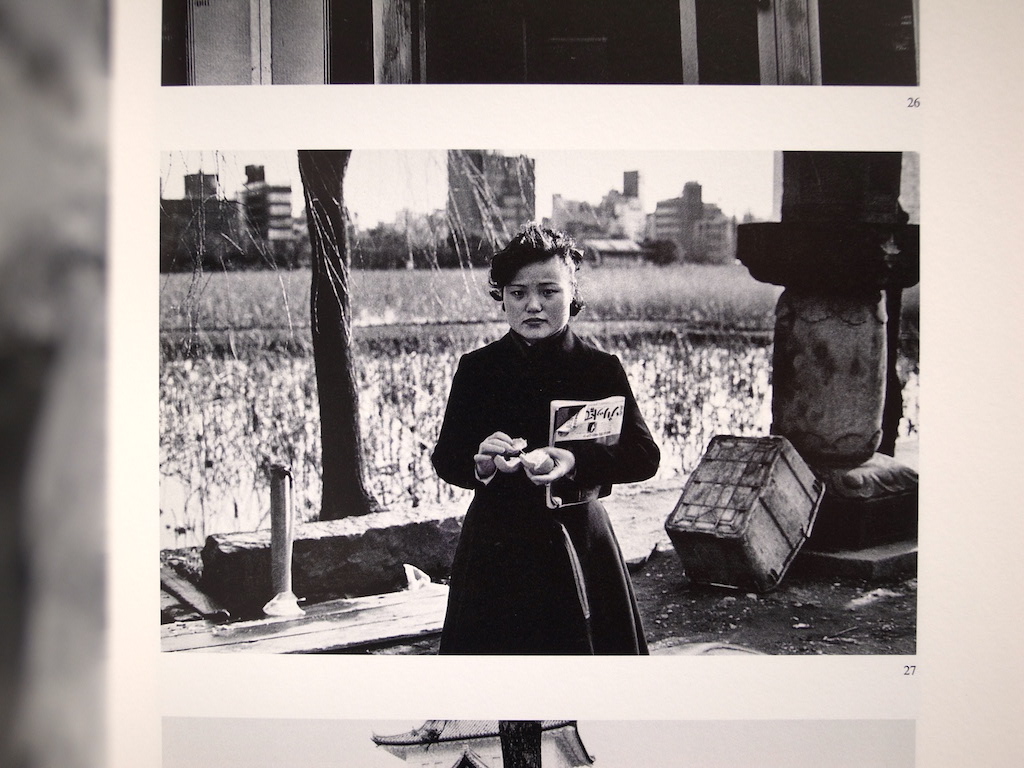
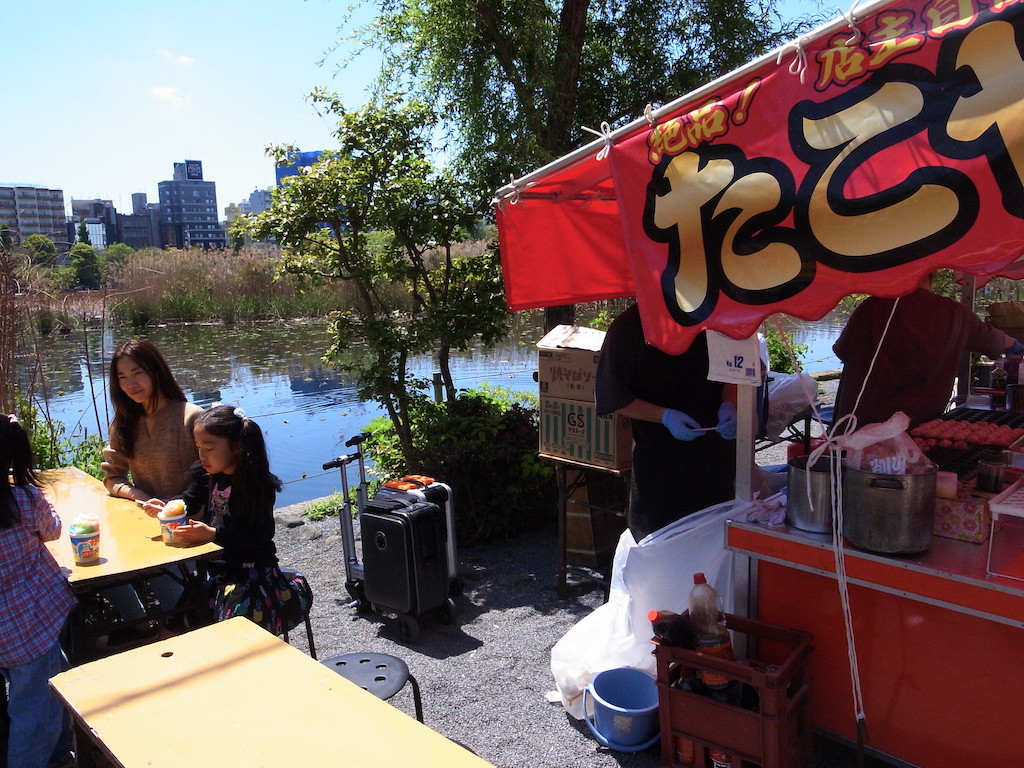
And today: そして現在。
* * *
Just as we’ll never know how many people have fallen into Shinobazu pond, it’s impossible to know how many photos have been taken on this particular island- or, in a broader sense, any place, ever.
My interest remains in discovering how photographs simultaneously connect and delineate differences in a place through people and the flow of time. Surely there are more here- I’ll keep my eyes open.
(But if you know of any other books, feel free to share.)
不忍池に落ちた人が歴史上で何人いるかわからないように、この島国で、いや、広い意味ではどんな場所でも、何枚写真が撮られたかを知ることはできません。
私にとってこの「Rephotography(リー・フォトグラフィ)」への興味というのは、写真というものが、人や時間の流れを通して、その場所のつながりを感じさせることです。同時に、違いを際立たせていることを発見することにあります。
この弁天島の写真はきっと他にもたくさんあるのでしょう。目を凝らしてみます(ご存じの写真集があったら、ぜひ教えてください!)。
■今回の写真集
須田一政『わが東京100』(初版1979年/復刻版2013年、禅フォト)
大西みつぐ『Wonder land 1980-1989』(十文字隼人映像探偵局、1989年)
大西みつぐ『Wonderland』(日本カメラ社、2008年)
須田一政『角の煙草屋までの旅』(Place M、2011年)
『アサヒカメラ』2003年6月号(荒木経惟掲載)
須田一政『凪の片』(冬青社、2013年)
 26 Duets? Duels? Near-overlaps of time and Space across Tokyo. 東京の時間と空間が重なり合う写真集ツアー
2025/04/04
26 Duets? Duels? Near-overlaps of time and Space across Tokyo. 東京の時間と空間が重なり合う写真集ツアー
2025/04/04
 25 Naoki Ishikawa "TOKYO The City Where I Was Born" 石川直樹『東京 ぼくの生まれた街』
2024/01/05
25 Naoki Ishikawa "TOKYO The City Where I Was Born" 石川直樹『東京 ぼくの生まれた街』
2024/01/05
 24 山内道雄 Michio Yamauchi『TOKYO UP CLOSE』
2023/10/20
24 山内道雄 Michio Yamauchi『TOKYO UP CLOSE』
2023/10/20
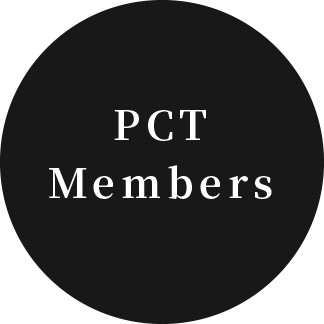
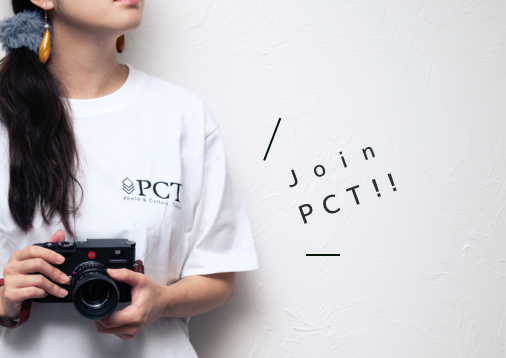
PCT Membersは、Photo & Culture, Tokyoのウェブ会員制度です。
ご登録いただくと、最新の記事更新情報・ニュースをメールマガジンでお届け、また会員限定の読者プレゼントなども実施します。
今後はさらにサービスの拡充をはかり、より魅力的でお得な内容をご提供していく予定です。
 「Photo & Culture, Tokyo」最新の更新情報や、ニュースなどをお届けメールマガジンのお届け
「Photo & Culture, Tokyo」最新の更新情報や、ニュースなどをお届けメールマガジンのお届け 書籍、写真グッズなど会員限定の読者プレゼントを実施会員限定プレゼント
書籍、写真グッズなど会員限定の読者プレゼントを実施会員限定プレゼント